Hanging up the hard hat
With no building in Phnom Penh higher than four storeys only 20 years ago, Cambodia's capital and many provincial cities have seen explosive development. But with the hard hats hung up on many smaller projects in recent months, how sustainable is the boom?
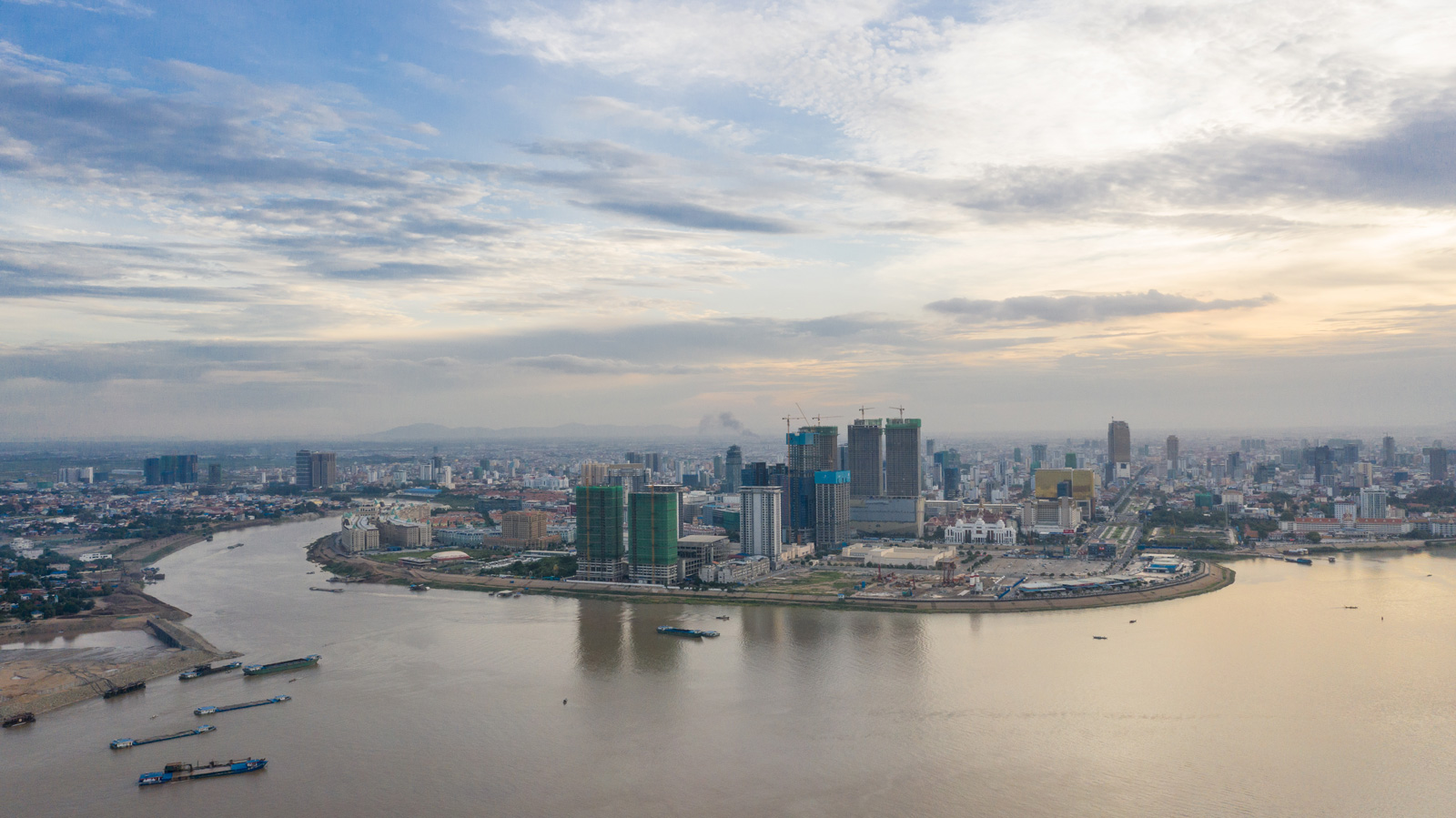
This is the third of our five-part series, Cambodia in Quarantine, investigating the impact of the global pandemic on the four pillars of the Kingdom’s economy – garments, agriculture, construction and tourism. A pillar will be published each day on our website, while paying Globe members will receive early access to the full report in a special e-magazine. Sign up now to get all the stories today and support independent journalism from across Southeast Asia.
Additional reporting by Kong Meta
Months into the Covid-19 crisis, the clatter of construction has grown fainter and fainter.
The pandemic, like in so many other respects, has exacerbated great divides between the resource-rich and resource-poor on Cambodia’s construction and finance landscape. While the mega-sites of Koh Pich, the man-made island in the Mekong River off the banks of Phnom Penh, are still humming with activity, construction activity elsewhere in the city and the country has fallen off as streams of investment have withered.
For workers at a site on a side-street just off Phnom Penh’s Botum Pagoda Park, the lack of construction capital has marooned them where they once worked. A group of six passed the time on a weekend afternoon in what might someday be a hotel lobby, perching themselves on construction materials set upon the sandy ground. Above them rose the concrete shell, wrapped and dormant in green mesh netting.
These six were the last ones left, stuck in the bare-boned structure waiting on backpay that may never come. Some were owed as much as three million riel ($730) and, though they needed money to pay down pre-existing debt, they were wary of leaving the site entirely, lest the middle-man who contracted their labour should deny them their wages. For now, they’re living rough, sleeping and cooking in makeshift rooms they’ve built of plywood and other site materials.
Reun Ry, 39, has been at this site for around five months. She’d come to pay off debt she’d incurred two years ago to buy equipment and materials for farming at her home in Kampong Cham, a venture she quit when drought spoiled her chance at harvest. At first, work in the city wasn’t too bad, and she earned about $7 per day.
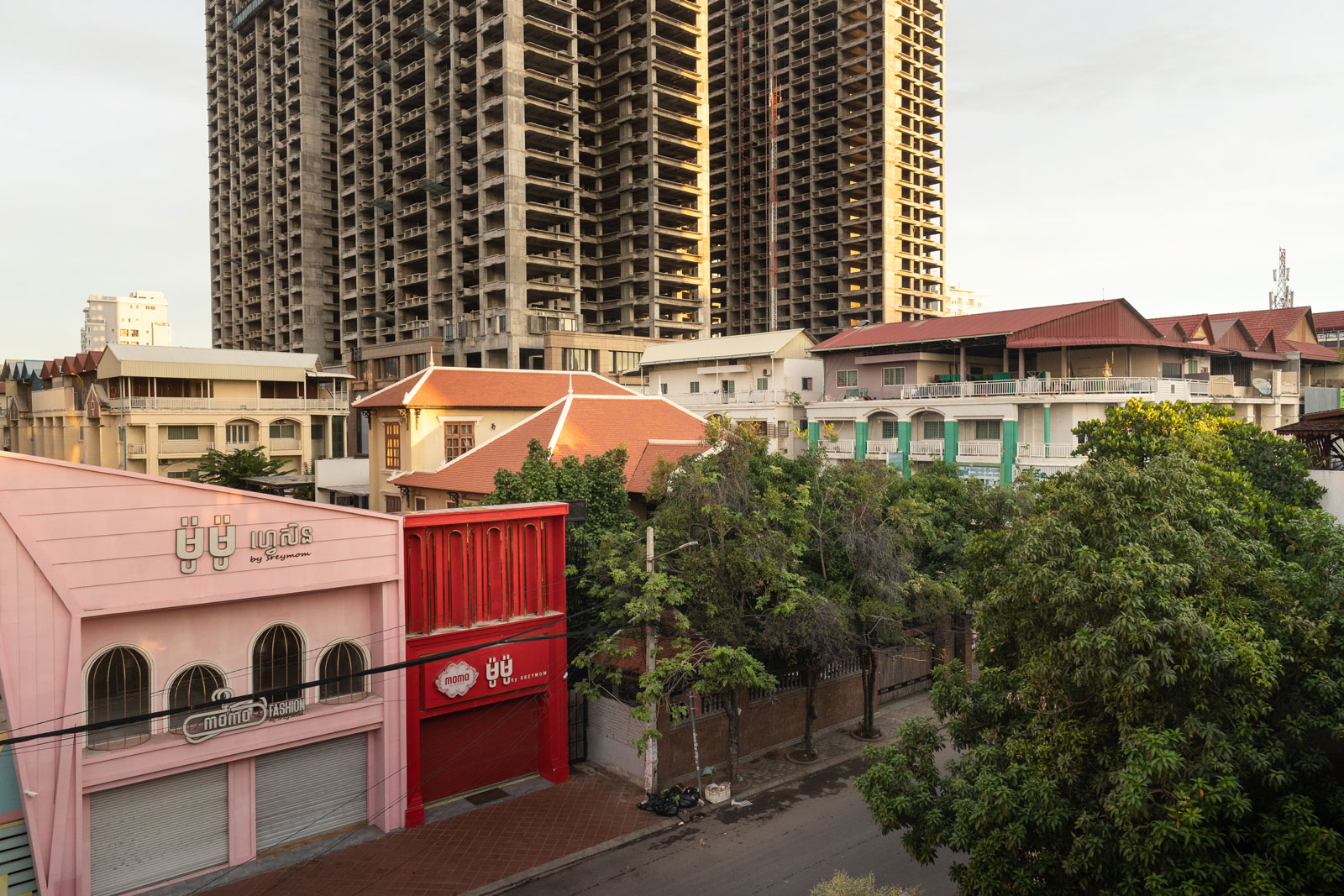
Around mid-May, that all changed. The crew of 20 who had been working the site were abruptly informed that their work was suspended. Two months later, most of the crew had trickled off, some into whatever they could find in Phnom Penh, others back to whatever they had waiting back home.
Ry and her husband say that’s not an option. Home is where their three children are, but it’s also where their creditors will find them.
“I asked my mother in the provinces to send me money to buy food, but now they are also broke,” Ry said, sitting on a wooden plank amidst the chaos of the construction site. “During these two months we also looked for jobs, but they told us already they had enough workers. Now we are stuck here.”
The workers are just a few caught in a wider net of a runaway construction sector now running aground on the shoal of Covid-19. Construction had emerged as a powerful and consistent engine of Cambodia’s rapid economic growth in recent decades, driven for the most part by foreign direct investment (FDI) from China and other large Asian economies.
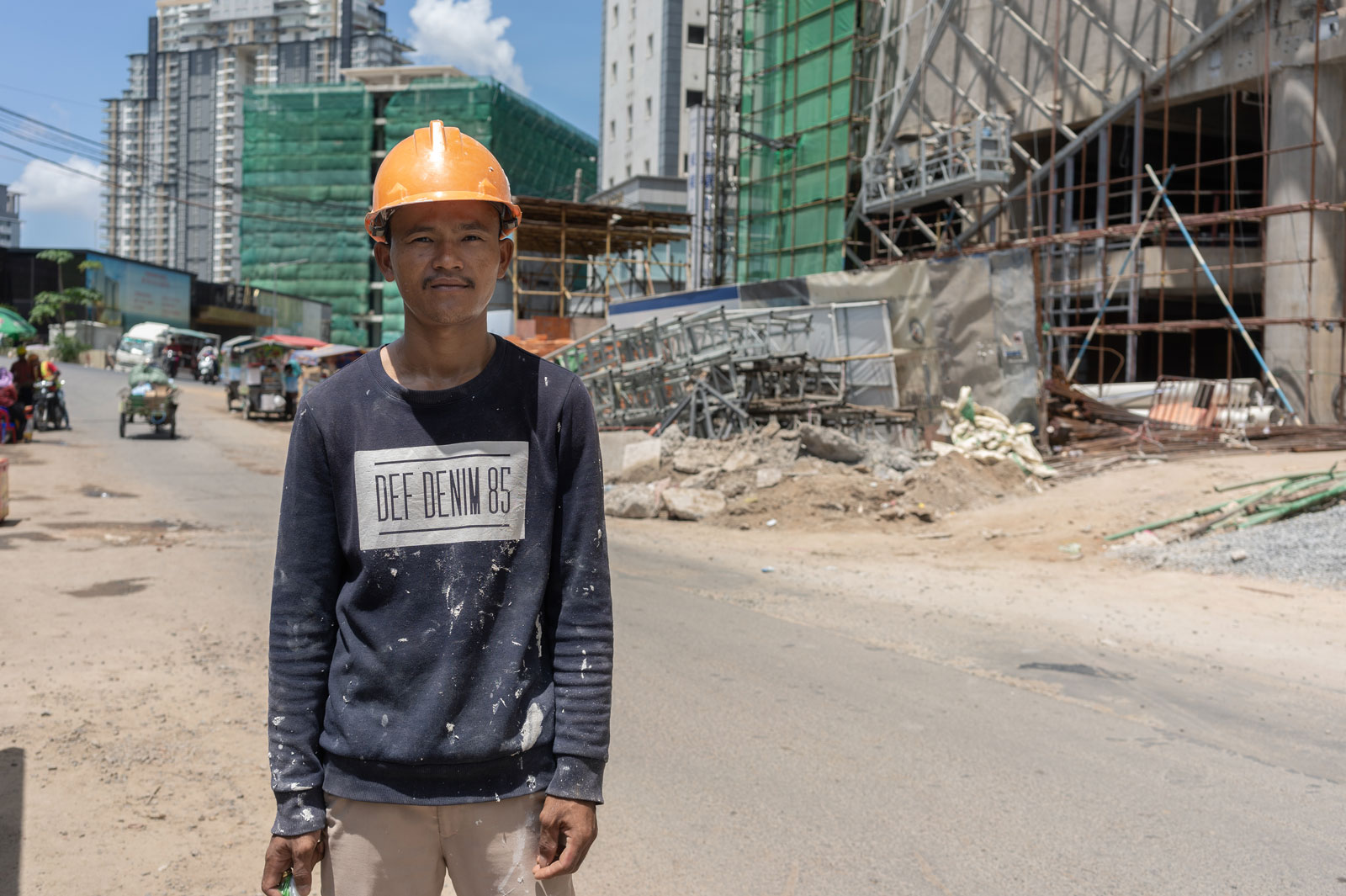
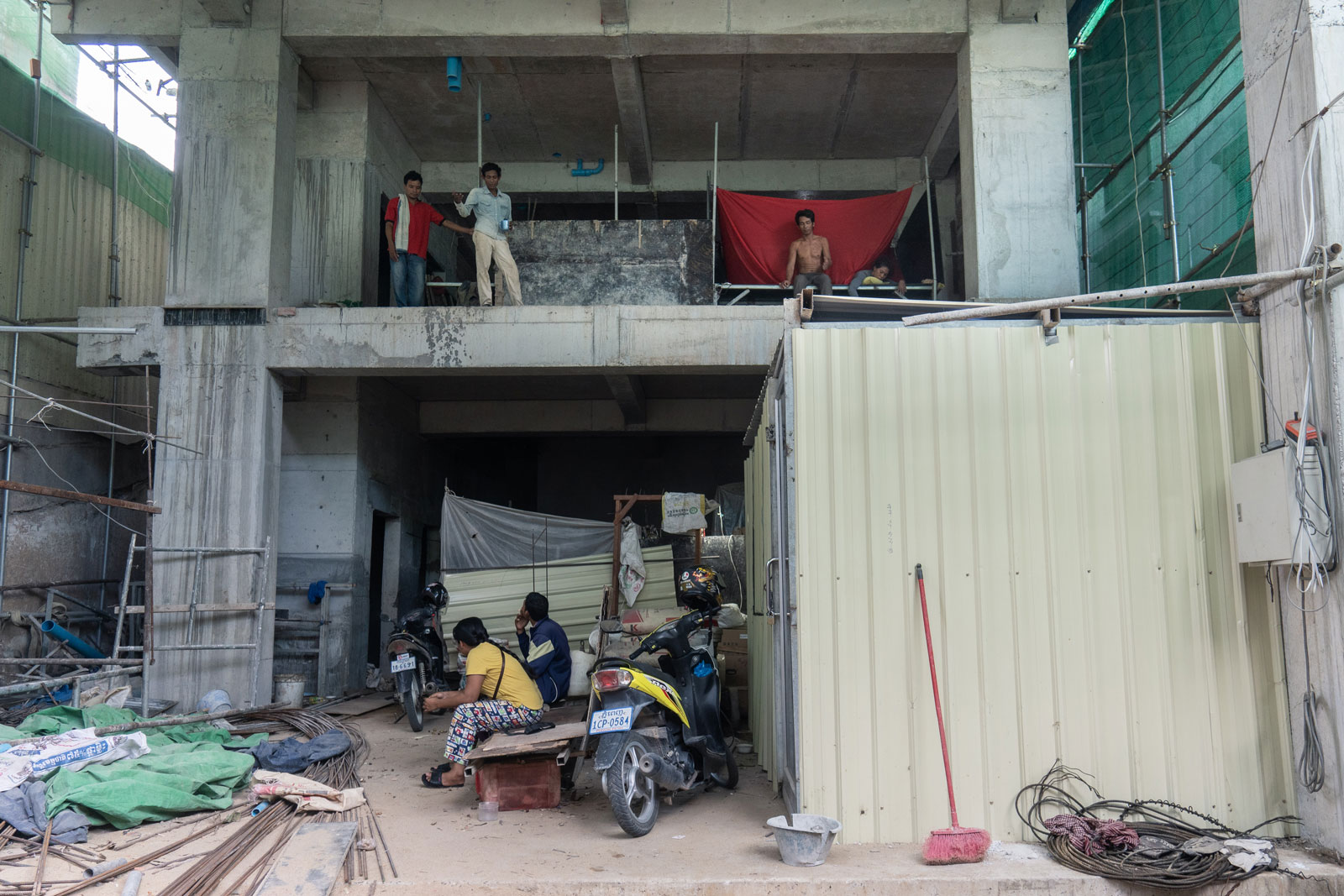
In 2019, FDI accounted for 13.29% of the Cambodian GDP of $26.7 billion, with the Council for the Development of Cambodia approving $3.5 billion in projects, about 43% of which flowed from China and Hong Kong.
The National Bank of Cambodia had initially forecast for 2020 a 10% increase in FDI. But in the first two months of this year, as the novel coronavirus virtually shut down the Chinese economy, FDI in Cambodia had been cut in half on the previous year. While Cambodia’s other industries get their share of FDI, construction is the Kingdom’s single-biggest target, capturing the majority of foreign investment.
Though it’s believed to account for only about 2.3% of official total employment – directly employing about 200,000 Cambodians – the World Bank reports construction accounted for almost 38% of GDP growth last year.
Meanwhile, local real estate firm IPS Cambodia advertises on its website some of the best value in ASEAN, marked by relatively affordable entry costs and high rental yields. It’s that kind of perspective, says James Hodge, country manager for international real estate company CBRE, that can still drive investor interest in Cambodian real estate even through the pandemic.
“For buyers from many other Asian markets, the Cambodian market represents good value for the money, especially in places where real estate is in less supply – Korea for example,” Hodge said. “They see the trajectory the market has taken over the last decade, two decades, so for many it’s still quite compelling and they’d like to be part of that.”
But for many buyers, even those with no intention of living in their investment property, it may be a turn-off to be unable to see the place before signing off on any purchase agreement. That’s the current situation thanks to pandemic-prompted travel restrictions that have, for now, put a hard stop on globalised travel.
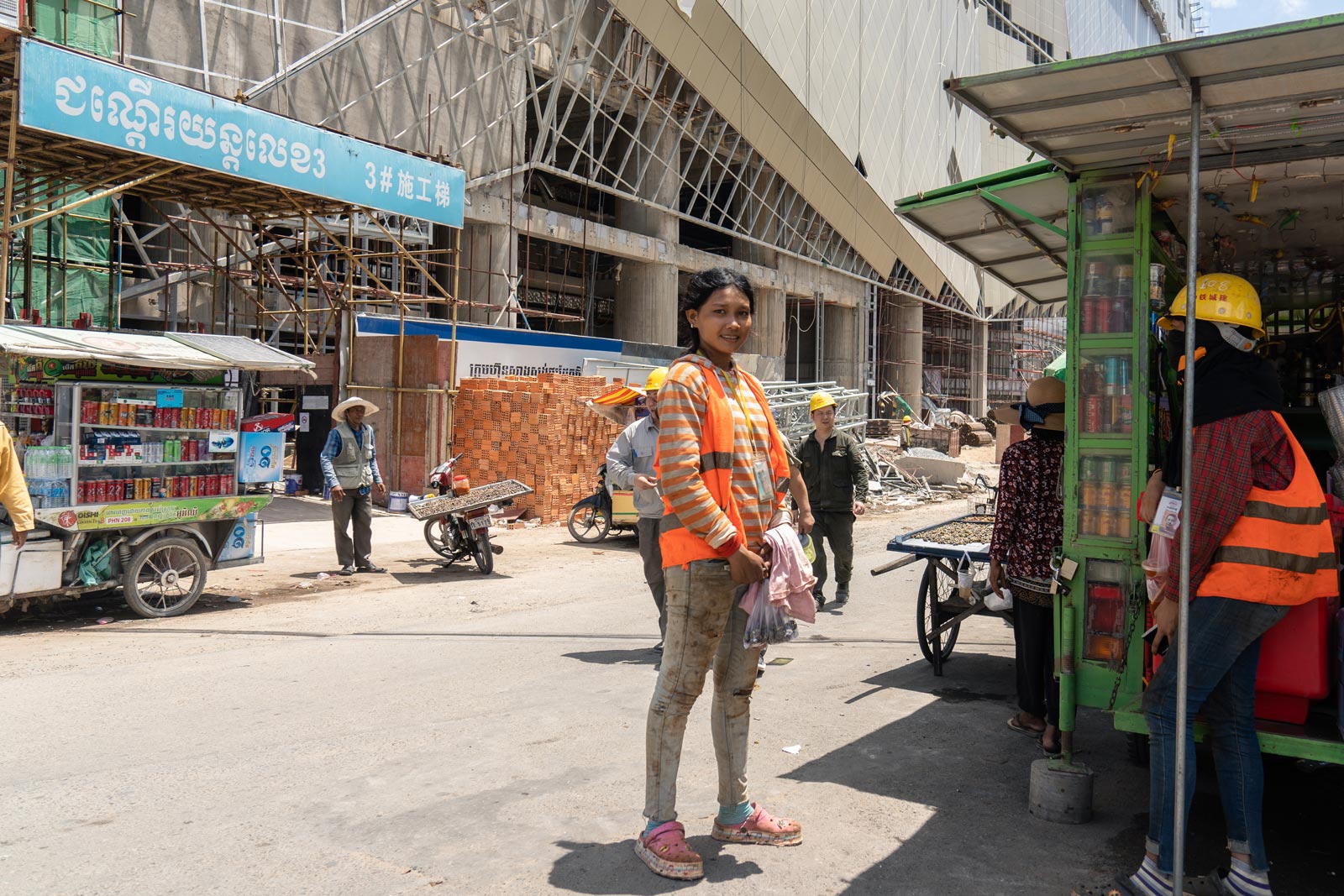
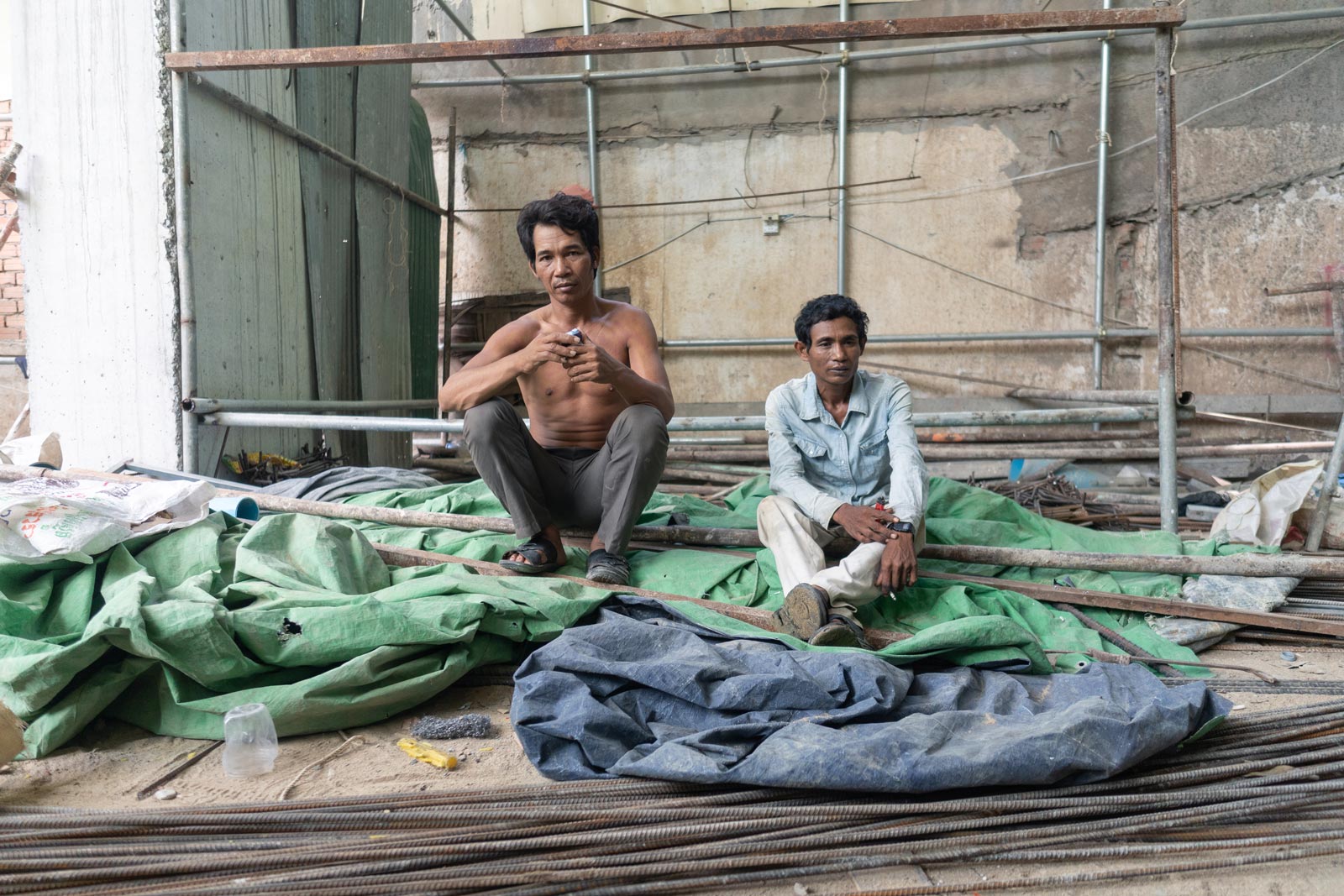
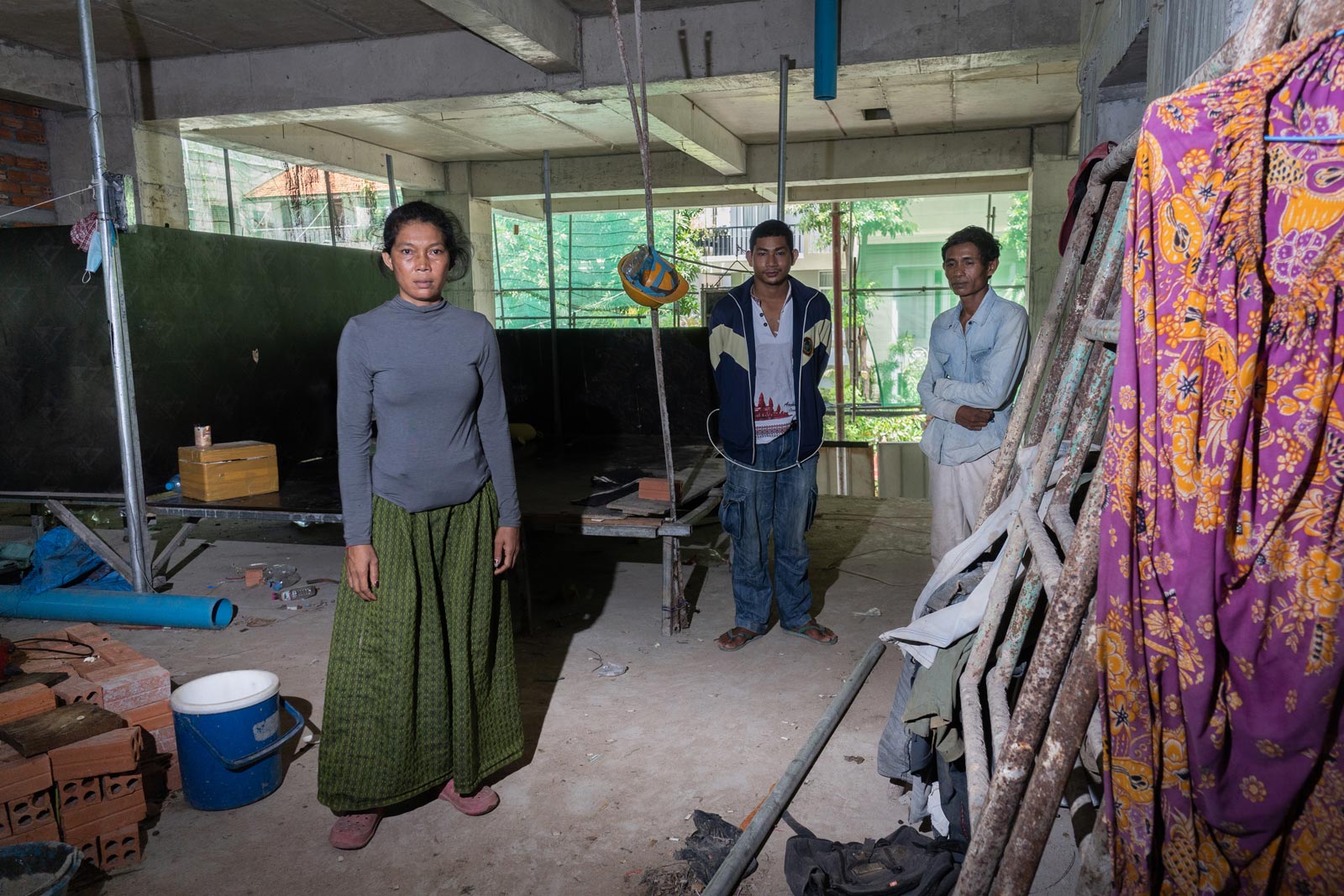
That’s part of what Stephen Higgins, managing partner at Mekong Strategic Partners, points to when describing the woes of the current development marketplace in Phnom Penh. He argues the construction sector was “too strong” before the downturn and the pandemic has prompted a serious correction.
“There might have been a [development] bubble here before, but it’s as if the bubble was sitting on some train tracks,” Higgins said, whose firm is staying afloat working with clients, mainly international development organisations, on infrastructure projects. “Then the train came, the virus, and smashed it all to pieces.”
Who would start a major project now? … You’d have to have rocks in your head
Stephen Higgins, Mekong Strategic Partners
Both he and Hodge described a similar, pre-pandemic landscape of development in which investors favoured high-rise condominiums, office towers and retail centres, many of which are pegged to a level of economic maturity not yet found among many Cambodian consumers.
Though Covid-19 may ultimately moot the conversation, where the two differed was in the details – namely whether, with the reduction of international buyers, projects would now be snapped up by a domestic market.
Hodge argued that it would, saying international development had led the market but that local consumers were catching up, in part due to pre-pandemic efforts by local builders to appeal to Cambodian tastes.
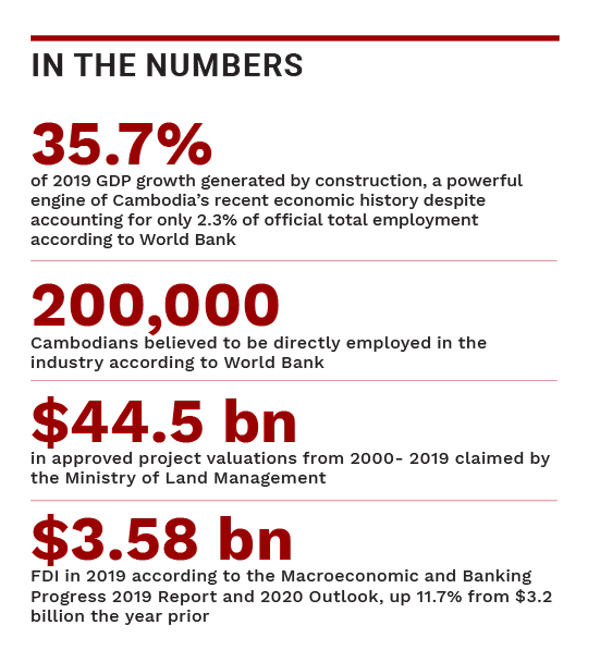
“It can take a few years to develop a stronger domestic market but the product has evolved into something more appealing to Cambodians, in terms of size, design and pricing – we’ve seen a lot more diversification in the sector now over the past few years.”
He added that most of the developers working with CBRE now seem to be using this time to reexamine their strategies rather than begin new projects, potentially turning inwards to domestic markets to make up for the lack of international demand.
Higgins, on the other hand, said he didn’t see the point of any of it and, in terms of the prospects of building this year, raised the ante even further.
“Who would start a major project now?” he said, incredulous. “You’d have to have rocks in your head.”
The buildings themselves, as the case may be, could also just represent a proverbial tip of the iceberg of capital and investment flows, with transnational agencies like Asia Development Bank (ADB) pointing to the investment market as a key indicator of the health of the rest of the economy as a whole.
In spring, the ADB made the worst prediction yet for economic decline in the Kingdom, forecasting a more than 5% contraction in GDP over the course of this year. Uncertainty is the order of the day, but Sunniya Durrani-Jamal, ADB country director for Cambodia, said her organisation is watching the progress of ongoing projects and the approval of new FDI proposals as a “clear indicator of investor confidence”.
“Given Cambodia’s openness, the monthly merchandise trade statistics give us a good indication of how the export-oriented sectors are developing, while imports of consumer goods, and construction materials can also be telling,” she said in an email to the Globe.
Durrani-Jamal also listed other metrics as possible tell-tales for an improving situation.
“The financial sector also gives us a good indication – both in terms of the volumes of existing loans that are being restructured due to changes in borrowers’ circumstances, and in terms of banks willingness and ability to extend credit to borrowers,” she added.
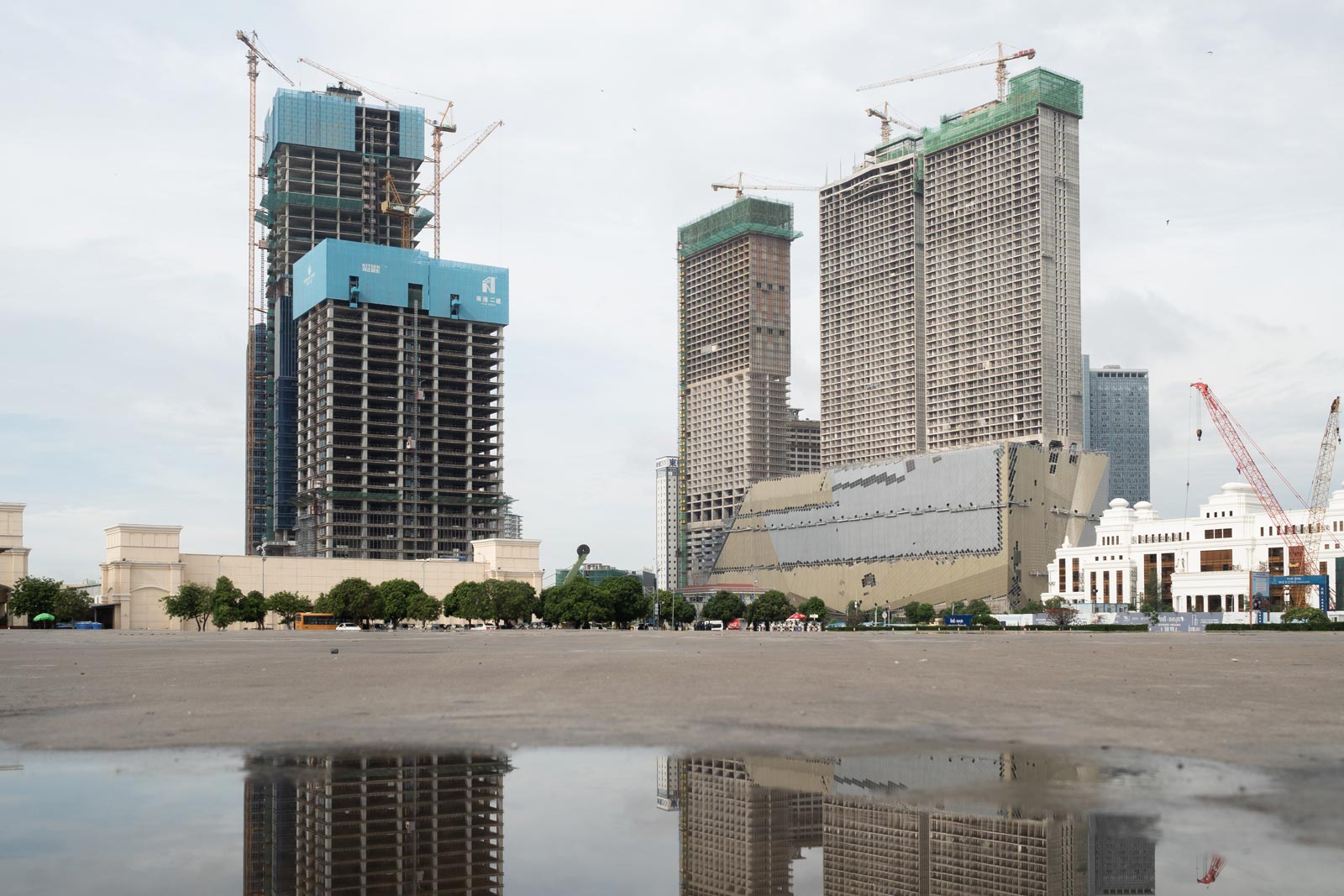
On this point, Credit Bureau Cambodia (CBC) CEO Oeur Sothearoath said the organisation’s data outlines a steep credit market decline in April, followed by a gradual recovery in recent months – a sign of recovering market confidence in Cambodia.
For an average month, Sothearoath said, the CBC gets about 450,000 credit inquiries, each representing an individual or organisation making a foray into borrowing with a Cambodian financial institution.
The first quarter of the business year, from about January to March, saw about 1.4 million credit inquiries to banks and other financial institutions, Sothearoath said. But when the second quarter started in April and authorities ordered soft lockdown conditions in Phnom Penh, credit inquiries dropped by some 40%.
The mid-spring plunge didn’t last though and by May things had already started looking brighter. In June, Sothearoath said, demand had almost entirely recovered to pre-pandemic conditions, with his organisation receiving around 400,000 credit inquiries.
However, while rising borrowing requests suggest an economy on the rebound, a more concerning trend is the number of restructured loan accounts in Cambodia, which has simultaneously ballooned. At the end of 2019, this category of the credit market formed a pool worth about $43 million. As of June, the total hit roughly $3 billion spread across some 238,000 accounts.
Sothearoath offers a few caveats to the sum, pointing out that it was previously unusual for Cambodian financial institutions to restructure loans, in which borrowers reschedule their payments. But the bulk of restructuring came after the National Bank of Cambodia instructed financial institutions, specifically those in microfinance, to widen eligibility criteria due to the pandemic.
“It doesn’t necessarily mean that, when they restructure loans, there is a big risk,” Sothearoath said. “But [financial institutions] are aware that some customers in tourism, garment factories are directly impacted by Covid-19.”
The delay and postponement of projects might not happen just yet, but you already see the number of project sites completely shut down and some mega projects have been delayed
Khun Tharo, CENTRAL
“Out of 238K restructured loans, banks have around 17% while microfinance has about 73%,” he added.
Even still, and maybe thanks to the expansion of restructuring, the percentage of non-performing loans (those that have hit 30-day-past-due status) has not grown as dramatically as some feared, rising from 1.4% at the end of 2019, to 2.5% as of June of this year.
“This number has increased a little bit,” Sothearoath said. “But that number is still small, it is still manageable.”
But while smaller, less secure projects like the hotel were left out to dry, the pandemic, considered the great leveler to many, has not hit all construction equally. Projects not far from the hotel were still humming with activity, fueled by massive investments secured long before the onset of Covid-19.
The Peak, a 55-storey, future skyscraper soaring above the Tonle Bassac river, is one such example. The three-tower complex is advertised online by developer WorldBridge International Group as a $580 million, multi-use project that will, upon completion, offer residents views of much of the city.
No doubt too they will see the Bridge, the neighbouring 45-story development WorldBridge finished in 2018 in partnership with Oxley Singapore, and maybe even the Palms, a $100 million resort by the same developer under construction on the languid Mekong a couple of kilometres upstream from Koh Pich.
These kind of megaprojects are still ticking along, for now.
Khun Tharo, programme manager at labour rights group CENTRAL, thinks it won’t be long yet before even these ventures grind to a halt.
“The industry, it’s not healthy for the long term,” Tharo said. “The delay and postponement of projects might not happen just yet, but you already see the number of project sites completely shut down and some mega projects have been delayed, leaving the workers to return to their hometowns.”
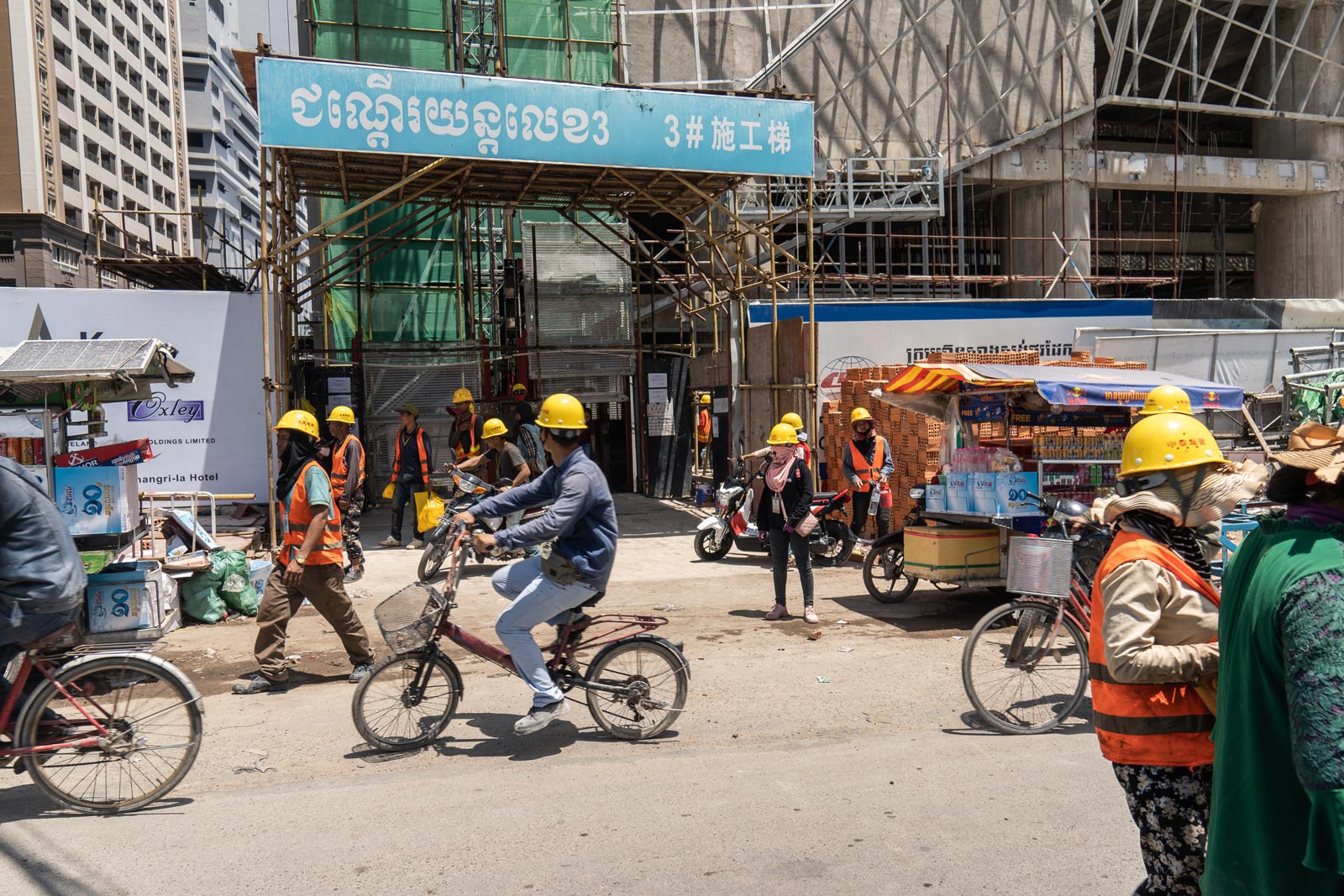
Even the Peak, he said, busy as it still is, is already behind schedule. The giant tower complex already had a lengthy construction timeline of about five years, but was initially expected to be finished by now.
Long before the pandemic conditions settled in, Tharo said, the construction labour workforce was a largely informal pool of men and women who had little protection in the way of site safety or social insurance. He pointed to a 2017 survey of the Solidarity Center labour group that estimated as many as 80% of the workforce could be classified as informal workers who toiled beyond the oversight of government regulations intended to protect them.
That would include the crew marooned at the someday hotel near Botum Pagoda, as well as others in a similar predicament even in the construction sprawl beneath the Peak. Sites there, advertised with glossy signs depicting glamourous tourists, residents and revelers in the Chinese-funded developments of a brighter tomorrow, have also gone quiet, save for the few inhabitants who lie waiting on bunks for the resumption of their labour.
At the Peak itself, worker Chhorn Thea recently stepped off-site for a quick lunch break and a drink of soda. The global economy was in contraction and his country was on the verge of its worst economic year in about a decade but, for Chhorn Thea, 30, things were looking ok.
“It’s hard to predict how the future will be, but right now, the work is fine,” he said, squinting in the sun outside his worksite at the massive WorldBridge building, just across the bridge from the island of Koh Pich, where even the land itself is man-made.
Compared to other jobs he could be doing, this gig he has now, painting walls in what will eventually be one of the tallest buildings in the city, isn’t half bad. In fact, looking just down the street at the quiet stone honeycombs of sites gone cold and dormant, Thea’s job and its $12.50-per-day wage feels almost improbable.
But he’s not thinking on those terms today. And, anyway, he said, finishing his cold drink and nodding to some visitors, he’s got to get back to work.
“Construction is easy,” he said with a shy grin, excusing himself and hustling back to the site.
Next the Globe will be looking at the impact of the pandemic on Cambodia’s tourism sector.

